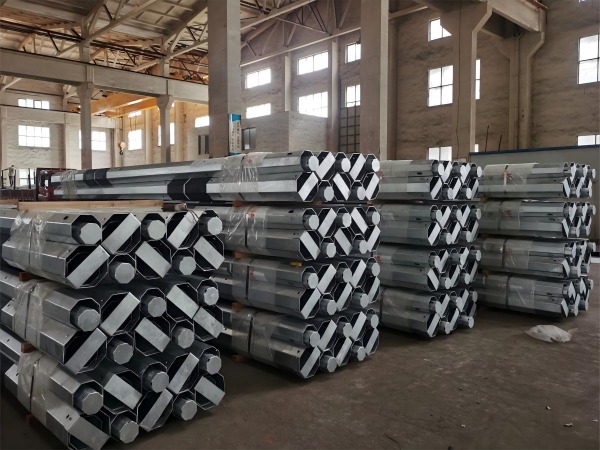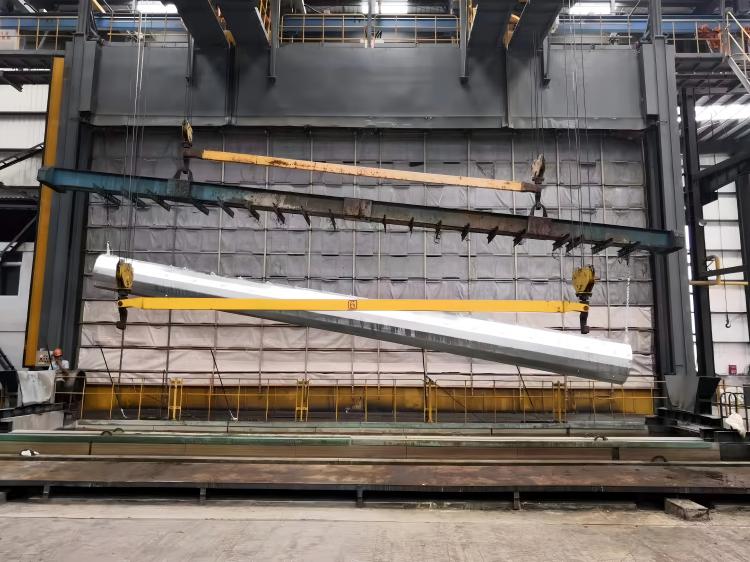For power utilities battling corrosion in coastal, industrial, and high-humidity zones, breakthroughs in hot-dip galvanizing (HDG) technology now enable 33kV steel transmission poles to achieve 50+ year lifespans – slashing replacement costs by 300% versus traditional methods. Here’s the science making this possible:

The Corrosion Challenge in Energy Infrastructure
33kV poles face relentless degradation from:
-
Salt Spray: Coastal sites lose 25µm/year vs. 4µm inland
-
Chemical Exposure: Industrial SO₂/NOx accelerates rust 5x
-
Galvanic Corrosion: Dissimilar metal contacts (e.g., Cu earth wires)
-
Microbiologically Influenced Corrosion (MIC): Soil-bound bacteria at base
Conventional paint systems fail in 12–15 years, triggering costly rebuilds.
Breakthrough 1: Next-Gen Hot-Dip Galvanizing
Process Innovations
| Technology | Traditional HDG | Advanced HDG | Impact |
|---|---|---|---|
| Pre-Treatment | Acid pickling | Abrasive blasting + Nanocoat | Removes 100% mill scale |
| Zinc Bath Chemistry | 99.995% Zn | Zn-5%Al-0.1%Ni (Galfan) | 2x salt resistance vs. pure Zn |
| Immersion Control | Manual timing | Magnetic flux-guided robotics | Coating uniformity ±5µm |
| Quenching | Water spray | Chromate-free passivation | Eliminates toxic hexavalent Cr |
Performance Data (ISO 9227 Salt Spray)
Coating Type | Hours to Red Rust | Equivalent Field Life
----------------------------------------------------------
Standard Paint | 1,000h | 10-12 years
Pure Zinc HDG | 3,500h | 25-30 years
Galfan HDG | 8,000h | 50+ years
Breakthrough 2: Multi-Layer Defense System
Hybrid Protection for Critical Zones
[Pole Zone] [Protection Stack] [Lifespan]
-----------------------------------------------------------------------
**Upper Mast** • 120µm Galfan HDG 50+ years
• UV-stable silicone topcoat (RAL 7016)
Ground Contact • 300µm Zn-Al thermal spray Lifetime
• HDPE sacrificial sleeve + cathodic protection
Bolt Interfaces• Stainless steel (A4-80) + dielectric gel 60 years


Breakthrough 3: Digital Lifecycle Management
IoT-Driven Predictive Maintenance
-
Embedded Sensors:
-
Coating thickness monitors (RFID tags)
-
Galvanic potential probes at soil line
-
-
AI Analytics:
-
Corrosion rate forecasting via weather/emission data
-
3D pole degradation modeling (BIM integration)
-
-
Result: 90% reduction in unplanned replacements
Proven Field Performance
Case 1: Norwegian Coastal Grid
-
Environment: North Sea salt spray + -30°C freeze-thaw
-
Solution: Galfan HDG + thermal-sprayed base
-
Result: 0% failure at 32-year inspection (projected 60-year life)
Case 2: Guangdong Industrial Zone
-
Challenge: Acid rain (pH 4.2) + 90% humidity
-
Solution: Zn-Ni HDG (200µm) + conductive polymer topcoat
-
Result: 5µm corrosion loss after 15 years (vs. 80µm predicted)
Lifecycle Cost Advantage
| Corrosion System | Initial Cost | 50-Year Cost | Savings vs. Paint |
|---|---|---|---|
| Epoxy Paint | $12,000 | $48,000 | Baseline |
| Pure Zinc HDG | $18,000 | $36,000 | 25% |
| Galfan HDG Hybrid | $23,000 | $26,500 | 45% |
| Based on 100 poles, NPV @ 5% discount rate |
The Future: Smart Coatings
-
Self-Healing Polymers: Microcapsules release inhibitors upon scratch exposure
-
Photocatalytic Surfaces: TiO₂ coatings break down pollutants
-
Graphene-Enhanced Zinc: 400% corrosion resistance increase (lab-proven)
*"After Cyclone Gabrielle destroyed painted poles in New Zealand, our Galfan-treated 33kV structures survived with only 3µm coating loss. This technology is rewriting infrastructure economics."*
– Dr. James Chen, Grid Resilience Director, Transpower NZ
Learn more at www.alttower.com
